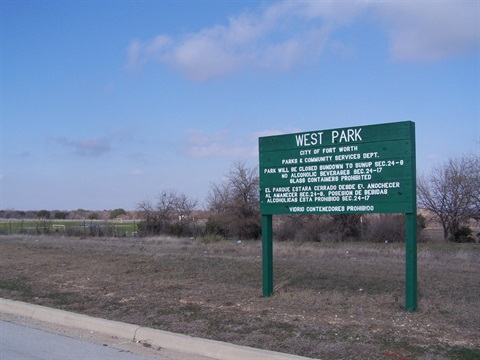West Community Park

Dedication
Size
Additional amenities
- Parking lot
- Restroom
- Soccer field
- Trash
Fun facts
West Community Park is located on the west side of Fort Worth. In February 1999, the Parks and Community Services Department (previous Park & Recreation Department name) determined that the City-owned property was suitable for recreational development. On July 6, 1999 (M&C G-12601), the City Council authorized Phase 1 development of the site from the 1986 Capital Improvement Program funds originally identified for land acquisition. In 2007, the property was dedicated as parkland. The park houses the Fort Worth Police Department's Mounted Patrol equestrian facility and Fort Worth ISD's FFA. The facility was constructed in 2014. “Not only does the Mounted Patrol serve an important operational function in fighting crime and protecting people and property, but it also remains an important symbol of our city’s rich culture and history,” said Mayor Betsy Price.
Currently, the park has a few recreational amenities such as soccer fields but generally is undeveloped. There are some unmaintained natural surface trails.
The park is near the shore of Lake Worth with plans to eventually connect a trail system through the park and to the lake. The 'back 40' of the park is a mix of Fort Worth Prairie and live oak woodland habitat. Typical species of Fort Worth Prairie include little bluestem, seep muhly, pale yucca, gayfeather, white rosinweed, eryngo, Texas sage, and bluebells. White rosinweed (Silphium albuflorum) and Pale yucca (Yucca pallida) are native, endemic plants that grows nowhere else in the world except in the limestone rocky barrens of Fort Worth Prairie habitat. Tree species include live oak, and mesquite. Where you find prairie meeting the woods in North Texas, there you often find praying mantis and walking sticks! The prairie is also a great place to find a diversity of butterflies and grasshoppers.
The geology of the park is what defines the vegetation and thus the wildlife species. The shallow soils of Maloterre, Aledo and Brackett soils lay atop calcareous limestone geology. Early Cretaceous Walnut clay and Goodland Formation limestone encourage prairie and make the environment a little less friendly for trees. However, trees are able to gain a foothold in a prairie ecosystem absent the natural process of fire.
View animal, plant and insect species observed at West Park and make some of your own observations through iNaturalist. See link under the "Related information" Section.
Reserve this park on ActiveNet
Location
8787 Heron Drive, Fort Worth 76108 View Map
32.79906,-97.475737
8787 Heron Drive ,
Fort Worth 76108
8787 Heron Drive ,
Fort Worth 76108
West Community Park